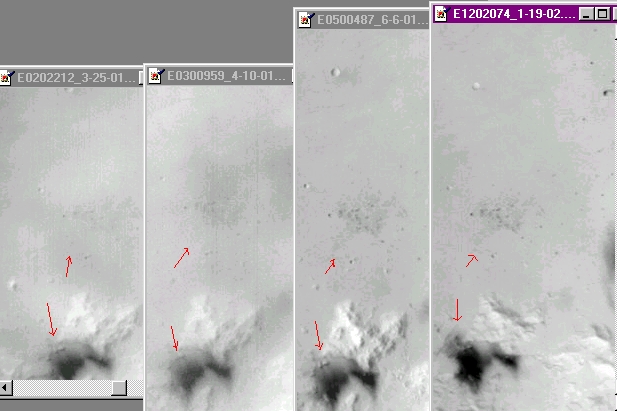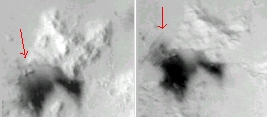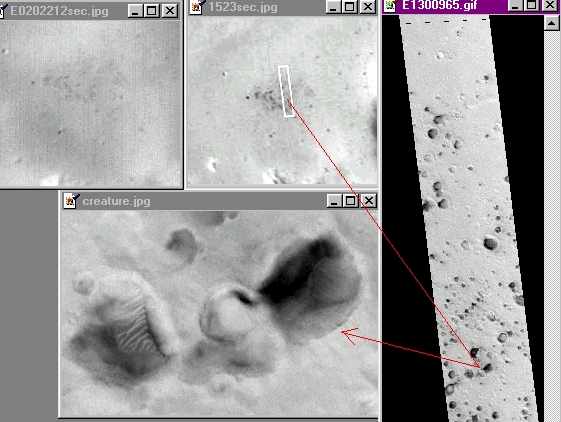The above photo is 2.98km in width
The above photo (section of E1300965) shows numerous sizes (one at least 1700ft.)
of what appears to be
exposed areas of creatures that are bobbing(?) for water or food. On Mars life has
adapted to the desert sands
like some of the mammals that swim in the oceans on Earth. There is another section of
this photo which shows
a face of one of these creatures (its head is over 100 ft. in diameter and the eyes are at
least 9 ft. across).
There is also something near the bottom of only one of the wide angles
(E1202074)(at least 1000 ft. across)
that is not in any of the other three shown. It has to be alive because only living things
move. There seems to
be evidence of much life in this region. There is no impact crater and meteors don't look
hollow like this does.
There are over 25 wide angle photos of the same location in Syrtis Major (271.3W
4.3N). (Someone on the inside
knows that there is something very unusual down there). While it is difficult to ascertain
movement at these
resolutions, we have a unique difference over time as illustrated in these series of wide
angle photos below.
Please note how the area is getting darker and fuller over time. This could only happen
if these are living
organisms that are either growing or surfacing. Note in the closeups how they appear to
be emerging from
squirrel-like burrows. At the bottom is a closeup comparison from the two overlapping
narrow angle high resolution
photos. The facial expressions appear to be different. The eyes look open in one and
squinting in the other.
In summary: First, the wide angles show a definitive change over time regarding the
darkening "blotches"
on the landscape. Second, the high resolution photos show creatures emerging from
burrows or mounds in
the landscape(Photo above: E1300965 & below). Third, the second high resolution
photo (E1401522) shows the same creature
with a different facial expression. Fourth, the wide angles show something near the
bottom (like a dinosaur with its
mouth wide open jutting up through a burrow?)(E1202074)
It has been several weeks since I wrote the above ideas of what is hapening in Syrtis
Major. After more research and discussion I have a better idea of what is going on. The
creature or rodent as many have called it is a gardener. It made shallow burrows for the
vegetation we see. The aeolian patterns are sometimes criss-crossed which can occur
in vegetation but not in sand dunes. The vegetation "stores" the previous wind patterns
because it has roots. Sand has no roots and therefore takes on the appearance of the
most recent wind patterns which erase any previous patterns. The patterns in sand
dunes will always show the same general direction. Vegetation stores patterns by its
very nature to hold fast to its location. So, the "gardener" burrows down to the water for
the vegetation to sprout and at the same time provides a wind break while the
vegetation is young and fragile. The vegetation provides the "gardener" with water
much like the grasses of the desert plains in the United States provide the only water for
the prairie dogs. In order for life to continue in an ecosphere there has to be enough
elements to complete a circle of exchange. Otherwise, over eons of time it comes to a
halt because the water the plants ate wasn't eaten and recycled to the environment.
We have an ecosphere that continues to survive on Mars. In the last century Dr. Frank
Salisbury stated, "it not only survives but it flourishes." We have never measured the
UV radiation on the surface of Mars. But, scientists knew in the 1940's that Mars had a
protective layer in its atmosphere that blocked blue, violet, and ultraviolet light most of
the time. There are periods they could measure, even then, when severe UV radiation
would hit the surface in places. They could measure the effect it had on the vegetation
and it confirmed their theories. When the hole in the protective layer in the atmosphere
occurred there was no seasonal change in the vegetation. The Beagle 2 lander will
measure UV in three different frequency bands.
Note: All photos are identified by their number and or
the date they were phototgraphed.
NOTE: All photos are courtesy of Malin Space Science Systems, the Mars Orbital
camera and NASA.
THOUGHTS: The life on Mars is similar enough to be recognized. But, beyond that
we have no concept of what it is
or how it functions or anything else about it. We can see it is gigantic and very slow.


 <---What is
this?
<---What is
this?



 <---What is
this?
<---What is
this?
